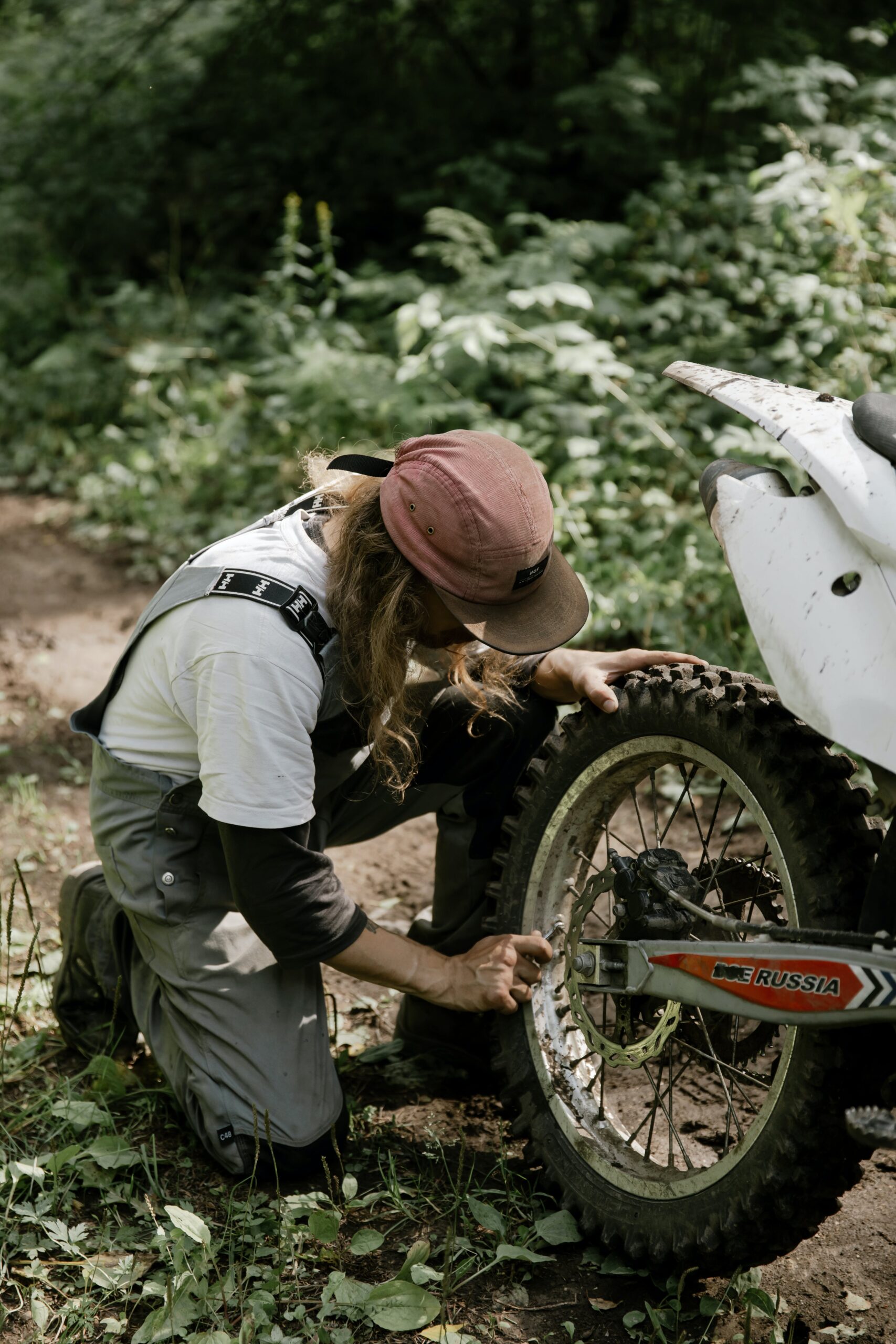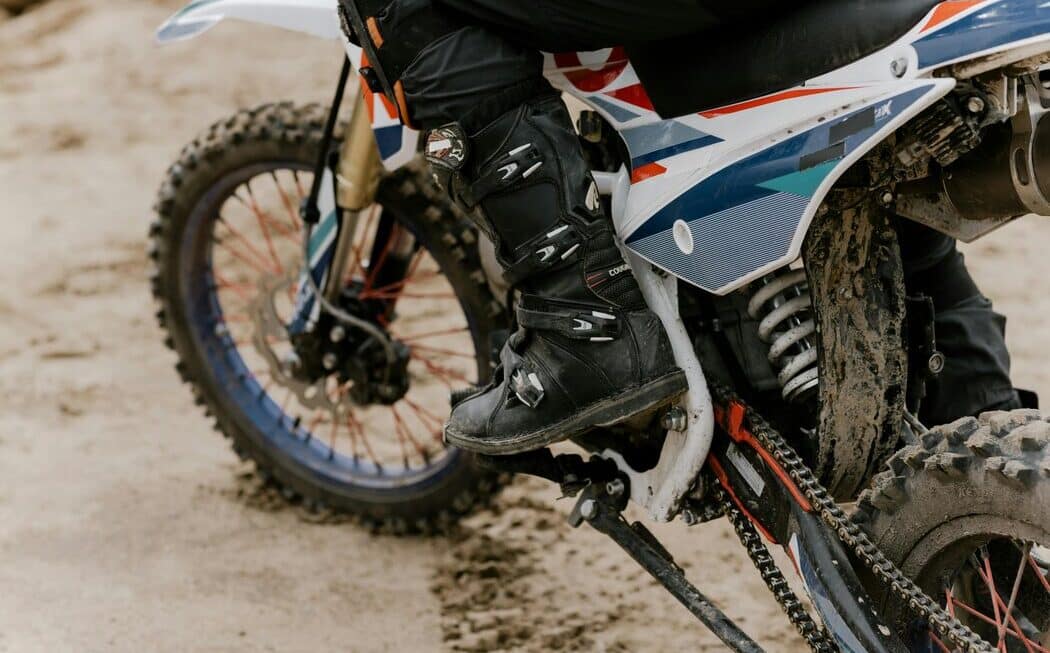Riding a dirt bike is an extraordinary experience that excites those who have the privilege of doing so. However, just like any mechanical vehicle, dirt bikes need proper maintenance to perform at their best and remain safe for use. One key step in keeping your bike in working condition is to regularly tighten its chain. Now if you don’t know how to tighten dirt bike chain, read this article carefully.
If the dirt bike chain is too loose or too tight, it can cause performance issues and even damage the components if it comes off completely in rough terrain. For this reason, it’s important to know how to tighten dirt bike chain. This article will explain the steps needed to correctly tighten a dirt bike chain so that you can safely enjoy your ride every time you hit the trail. Taking proper care of your chain not only ensures better performance but also increases its overall life span.
Chain Function
The chain on a dirt bike plays an incredibly important role in the operation of the dirt bike. It is responsible for transferring power from the engine to the rear wheel, allowing the bike to move. Without a properly functioning chain, the bike would not be able to deliver its full performance potential. Keeping your bike’s chain in good condition is essential, and it’s important to check it regularly. This will help ensure that you get maximum performance from your machine as well as minimize premature wear or other performance issues.
Besides regular cleaning and lubrication, inspecting the tension of your chain is especially important for keeping it performing optimally. Chains stretch over time with use, so they must be adjusted regularly using a special tool like an adjustable ruler or caliper to maintain proper tension and alignment. Additionally, replacing worn-out chains must also be done frequently to prevent any serious issues from arising. With consistent care and maintenance, your dirt bike’s chain should last much longer while delivering top-notch performance whenever you need it most.
Signs of a Loose Chain
A loose bike chain is a common problem, and it can lead to an array of issues if not addressed. Signs of a loose chain include excessive slack when using the three-finger method to check the chain tension. Additionally, sprocket wear could be accelerated as a result of a floppy and loose chain. The faster the wear is, the more likely that the drive train parts will have to be replaced sooner rather than later.
Chain derailment can potentially occur due to a loose chain if not paid attention to in time. It happens when too much force is delivered onto the chain which causes it to misalign and thus makes it slip out from its original position while riding. Derailment can be extremely dangerous, therefore preventive maintenance should always be taken seriously. Such preventive measures include tightening your chain, verifying clearance between sides of your swingarm and absorber at all times, lubricating your entire drive system regularly with specific motorcycle lubricants, and finally making sure that you clean and check your entire drive system for leaves or other debris buildup.
How to Tighten Dirt Bike Chain (Step by Step Process)
Step 1: Tool Inspection
Before beginning any repair work on your bike’s chain, it is important to inspect all of the tools that you will be using. Make sure that the size of your tools is appropriate for the components you have available too; bearings and fasteners may come in varieties of sizes and if your tools are too large or too small they won’t do much good.
Inspection not only goes for those bigger pieces but also checks the little things such as bolts and pins. You should also ensure that all nuts and bolts appear to be properly tightened so that when used on your bike repairs they remain stable.
Step 2: Wear Protective Gear
When handling a dirt bike chain, wearing protective gear is a must. Gloves are highly important as they can not only protect your hands from sharp edges and possible pinching injuries but also provide grip so you don’t slip when using the chain. Wear safety glasses to protect your eyes from any debris or lubricant that could splatter onto your face during maintenance. Even if you feel confident in your safety measures, it’s still advisable to take the necessary precautions.
It’s also important to consider what type of gloves you are using while working with the dirt bike chain. Look for gloves made from thick material such as cowhide leather or reinforced canvas that will offer extra abrasion resistance. Keep in mind that work gloves without knuckle protection offer inadequate protection, so select versions with additional layers of padding over vulnerable areas such as the fingertips and palms. Also, make sure the fit is snug yet comfortable. By making sure you have taken these steps before working on a dirt bike chain, you can avoid uncomfortable injuries and play it safe all along.
Step 3: Gather Necessary Tools
Before beginning to adjust the chain of your dirt bike, you must first gather the appropriate materials needed for the job. A sturdy bike stand is essential for being able to hold up the bike and make easy adjustments. You will need either a socket set or wrenches compatible with your axle bolts. Additionally, using a torque wrench (which is optional) may prove beneficial for properly tightening your adjustments. To clean any of the grime from around your chain, a degreaser and a brush (like a grunge brush or toothbrush) are necessary items to make sure that surrounding areas are debris-free.
After having gathered all necessary tools you can move on to locating the chain adjusters: these usually lay at the rear of the swingarm near the rear wheel axle and should be easily identifiable due to their L-shape design as shown in the aforementioned illustration. With your tools gathered and your adjusters located, you can begin to tighten and adjust your chain accordingly until it’s perfectly aligned.
Step 4: Clean the Chain
Cleaning the chain is an important step in taking care of your bike. It ensures that you have an accurate measurement of chain slack. To clean the chain properly, start by spraying it down with a chain degreaser to remove dirt and grime. Make sure to use a spray bottle for even distribution of the degreaser. After doing this, take a brush and give it a good scrubbing, either with a specialized grunge brush or a toothbrush. This will dislodge any remaining debris on the chain links. Finally, rinse off the degreaser and loosen the dirt with water; be gentle so you don’t cause any further damage! A clean chain is essential for maintaining bike performance, so make sure to keep your bike in top condition by cleaning its chain regularly.
Regularly maintaining your bike’s chain is essential to long-term performance and longevity. Cleaning the chain brings many benefits – from improved accuracy in measuring slack length while adjusting tension to ensuring proper mechanical function when riding mountainous terrain or during races. Whether you’re a casual rider or a professional cyclist, keeping your bike’s chains running smoothly
Step 5: Position the Bike Properly
Once in position, all adjustments should be made from the bottom bracket side of the drive train, with both pedals in their forwardmost positions. Make sure that both chain ends are exactly equal in length before making any further adjustments. Check that all bolts and components are adequately tightened to guarantee perfect driving conditions. It is also important to inspect other parts like derailleurs, cables, and shifters for correct settings and functionality.
By closely following these steps, you can easily obtain an optimal chain adjustment for your bike which will ensure a comfortable yet powerful riding experience for years to come. Committing some time upfront towards proper bicycle maintenance pays dividends throughout its lifetime use when done correctly!
Step 6: Loosen Axle Nut
Adjusting the tension of a bike’s chain is an important part of routine maintenance for cyclists. To adjust the chain properly, it is important to loosen the axle nut securing the rear wheel in place. This nut can be difficult to loosen since it is secure by threads and often corroded. Use a wrench or other suitable tool to carefully loose the axle nut, however, do not remove it completely as that would render your bike immobile.
When adjusting a bike chain, make sure to always loosen the axle nut first before making any adjustments, as otherwise, you may damage your bike or pose a safety risk to yourself. Make sure that whichever tool you use is appropriate for loosening nuts on bicycles; generic tools such as adjustable wrenches can slip, so we do not recommend these tools. When finished with all of your adjustments make sure to retighten the axle nut very securely and make sure to check its tightness regularly while riding and during maintenance routines in case it has come loose over time.
Step 7: Measure Chain Slack
Measuring the chain slack on a bike is an important step in ensuring peak performance and maintaining it for years to come. To check your chain slack, you need to push up halfway between the front and rear sprockets. All bike manufacturers have different recommended chain slack measurements, so be sure to consult your bike’s manual or any available guidelines to ensure you are getting accurate results.
Generally speaking, the ideal amount of chain slack is 1.5 to 2 inches (3.8 to 5 cm) when pushed up and down on top of the chain. Too much or too little slack can cause serious issues with your ride quality, from grinding noises and slipping gears to an inefficient pedaling cycle due to excessive tension in certain parts of the drivetrain. Checking your chain regularly ensures that all parts of your bicycle will continue running optimally for years to come!
Step 8: Adjust Chain Tensions
Proper chain tension is essential for any bicycle. Without the right tension, your chain could slip off the cog, or even snap in half due to excessive stress. Adjusting the chain tensions requires a few simple steps.
First, you must start by loosening the axle nut on the rear wheel of your bicycle. Next, you will need to adjust the tensioners, which are usually located near both sides of the rear wheel. To achieve proper tension, you can simply turn the adjustment bolts clockwise or counterclockwise depending on whether you want to tighten or loosen it further. The best way to ensure that you’ve achieved optimum tension is by performing the three-finger test – which involves sliding three fingers behind your chain slider and making sure that it’s taut against them. If it’s too tight or too loose then keep adjusting until optimal tension is reached.
Step 9: Check Chain Alignment
Proper chain alignment is essential for a smoothly running dirt bike. After tightening the chain tensioners, make sure that the chain runs perfectly straight when the bike is wheeled forward and that there is an even gap between both sprockets and the chain itself. To check for proper alignment, you’ll either need a specialized tool or a visual inspection.
A misaligned chain can affect performance as well as cause unnecessary wear on components such as the sprockets. It can also be dangerous if left unaddressed, so it’s important to regularly inspect your chain alignment to ensure optimal performance of your dirt bike. Fortunately, checking and adjusting chain alignment is a relatively quick and easy process.
Step 10: Tighten Axle Nut
The axle nut is an important part of securing the rear wheel of your dirt bike, as it directly affects how well your bike rides. Before tightening the axle nut, it’s vital to ensure that the chain tension and alignment are up to standard. Allowing sufficient slack in the chain will result in smoother functioning and reduced wear on other components, whereas too much tension can cause damage down the line.
To properly fasten the axle nut, one should ensure they apply enough pressure but not so much that they cause further damage or unnecessary tightness. Do this by hand instead of using power tools, as it’s easier to achieve the right torque balance and makes it easier to back out if needed. Double-check your work before finally taking off for a ride; ensuring that everything is still in order ensures you won’t run into any issues later down the line!
Step 11: Re-check Chain Tension
Maintaining the right tension on your dirt bike chain is essential, and the process should start with tightening it. After tightening the chain, it’s important to periodically re-check the tension. Re-checking the chain tension helps ensure optimal performance and safety for riders.
To do so efficiently and accurately, begin by placing three fingers on top of one another behind the chain slider, allowing for the chain to drape over the index finger. A correctly tensioned chain should be moderately taut against your fingers. If it’s too loose or too tight, adjust it accordingly by following specific steps specified in your manufacturer’s handbook. This will ensure you get the perfect balance of tightness when riding on rough terrain surfaces or jumping obstacles. Additionally, regular material inspections also help with chain maintenance and prevent any malfunctions during a ride—such as an unexpected breaking or detaching of links due to excessive vibration or shock loads from impacts.
Final Step: Test Ride
A test ride is an essential part of the bike preparation process. Before taking to the road for a longer journey, riders must give their bikes a short test ride to check that everything is working as expected. During the test ride, focus on how the chain works; it should remain silent and consistent at any speed or over any bumps. If there are any signs of unusual sounds or vibrations in the chain, it’s best to stop immediately and re-adjust the chain tension before continuing.
Furthermore, a smooth chain operation will not only result in improved overall performance but will also extend your bike’s lifespan and reliability. Do regular inspections of your chains and components before each journey. As such, it is always recommended that riders take a few moments before setting off for a longer route to complete a quick test ride. Ultimately this preparation could save you time in the long term, resulting in a stress-free riding experience each time.
Ongoing Maintenance Tips
Ongoing maintenance is a must for any dirt bike owner. Taking the time to properly care for the chain can help ensure you get a long life and proper performance from your machine. The most important tip for ongoing maintenance is regular cleaning of the chain. Use a brush to remove dirt and debris, then apply chain cleaner to remove any additional grime. After that, lubricate with a specialized chain lubricant – this will reduce friction and wear on the components.
Next, monitor chain wear periodically by measuring its length with a ruler or special tool. Replace the chain if necessary – even small amounts of wear can significantly impact performance and increase the risk of breakage. Inspect sprockets before installing a new chain. Worn sprockets can cause damage to a new chain or vice versa so make sure they’re in good condition before riding again. Taking these steps can help you keep your dirt bike in optimal condition for longer.
Conclusion
Tightening the chain on a dirt bike is a simple procedure that can save you some money if done correctly. To do this, you first need to loosen the axle nut or chain adjuster and lift the rear wheel off the ground. Next, make sure there is enough slack in the chain and rotate it around the sprocket several times before retightening the axle nut or adjuster. Finally, check to make sure that the tension has been applied evenly throughout your new setup.
Once tightened, it’s important to periodically readjust the tension of your dirt bike’s chain. Over time, your chain will stretch with use which can then affect performance negatively if not properly taken care of. Follow the manufacturer’s suggested tightness guide when addressing any changes to avoid loosening too much or over-tightening and damaging your bike’s sprocket teeth. With just a few quick steps and some patience, you can successfully maintain peak performance from your bike’s drivetrain system while also saving yourself a significant amount of money by avoiding costly repairs or replacements!


